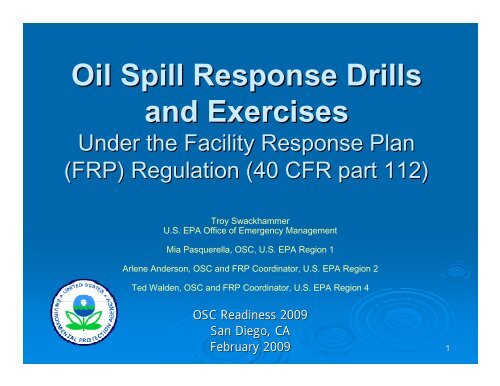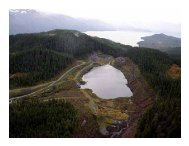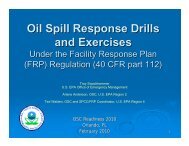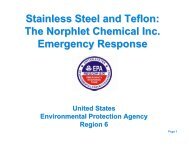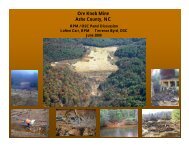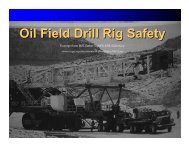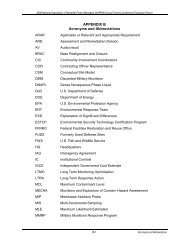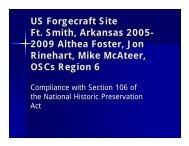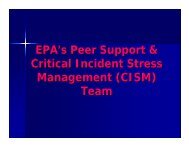Oil Spill Response Drills and Exercises
Oil Spill Response Drills and Exercises
Oil Spill Response Drills and Exercises
Create successful ePaper yourself
Turn your PDF publications into a flip-book with our unique Google optimized e-Paper software.
<strong>Oil</strong> <strong>Spill</strong> <strong>Response</strong> <strong>Drills</strong><br />
<strong>and</strong> <strong>Exercises</strong><br />
Under the Facility <strong>Response</strong> Plan<br />
(FRP) Regulation (40 CFR part 112)<br />
Troy Swackhammer<br />
U.S. EPA Office of Emergency Management<br />
Mia Pasquerella, OSC, U.S. EPA Region 1<br />
Arlene Anderson, OSC <strong>and</strong> FRP Coordinator, U.S. EPA Region 2<br />
Ted Walden, OSC <strong>and</strong> FRP Coordinator, U.S. EPA Region 4<br />
OSC Readiness 2009<br />
San Diego, CA<br />
February 2009<br />
1
Course Objectives<br />
‣ At the end of this course, students should have a<br />
better underst<strong>and</strong>ing of:<br />
• Drill <strong>and</strong> exercise requirements under the FRP<br />
regulation (§112.21)(<br />
<strong>and</strong> PREP guidelines<br />
• Purpose of the Government-Initiated Unannounced<br />
Exercise (GIUE) <strong>and</strong> how it relates to NCP, ACP, <strong>and</strong><br />
other preparedness activities conducted by industry,<br />
U.S. EPA, <strong>and</strong> U.S. Coast Guard<br />
• Steps in planning <strong>and</strong> performing a GIUE<br />
• GIUE evaluation criteria <strong>and</strong> implications<br />
• Common problems observed<br />
<strong>Drills</strong> <strong>and</strong> <strong>Exercises</strong> at FRP Facilities February 2009<br />
2
Contents<br />
‣ Introduction: Why exercise? Authority for Conducting <strong>Drills</strong><br />
Troy Swackhammer, OSWER/OEM<br />
‣ PART I: Background: Facility <strong>Response</strong> Plan Regulation &<br />
Preparedness Framework<br />
Ted Walden, Region 4<br />
‣ PART II: FRP Training <strong>and</strong> Exercise Requirements<br />
Mia Pasquerella, Region 1<br />
‣ PART III: Implementing a GIUE <strong>and</strong> “The Good, the Bad,<br />
<strong>and</strong> the Ugly”<br />
Arlene, Mia <strong>and</strong> Ted<br />
<strong>Drills</strong> <strong>and</strong> <strong>Exercises</strong> at FRP Facilities February 2009<br />
3
Introduction: Why Exercise?<br />
The effectiveness of spill response impacts the resulting<br />
environmental damage <strong>and</strong> cleanup cost.<br />
‣ 2007 GAO Report on <strong>Oil</strong> <strong>Spill</strong> Costs:<br />
• “The longer it takes to assemble<br />
<strong>and</strong> conduct the spill response,<br />
the more likely it is that the oil will<br />
move with changing tides <strong>and</strong><br />
currents <strong>and</strong> affect a greater<br />
area, which can increase costs.”<br />
• “The level of experience of those<br />
involved in the incident comm<strong>and</strong><br />
is critical to the effectiveness of<br />
spill response, <strong>and</strong> they can<br />
greatly affect spill costs.”<br />
<strong>Drills</strong> <strong>and</strong> <strong>Exercises</strong> at FRP Facilities February 2009<br />
4
Introduction: Authority for<br />
Conducting <strong>Drills</strong>/<strong>Exercises</strong><br />
‣ <strong>Oil</strong> Pollution Act of 1990<br />
• 311(j)(6)(A): Equipment Inspections<br />
• 311(j)(7): Tests of Facility Removal Capability<br />
‣ National Contingency Plan (NCP)<br />
• Area Contingency Plan (ACP)<br />
• Facility <strong>Response</strong> Plan (FRP) regulation requires<br />
facility response drills/exercises<br />
• Program must follow National Preparedness for <strong>Response</strong><br />
Exercise Program (PREP) (or alternative format approved by<br />
the Regional Administrator) [112.21(c)]<br />
‣ National <strong>Response</strong> Framework<br />
<strong>Drills</strong> <strong>and</strong> <strong>Exercises</strong> at FRP Facilities February 2009<br />
5
Introduction: Authority for<br />
Conducting <strong>Drills</strong>/<strong>Exercises</strong><br />
‣ National Preparedness for <strong>Response</strong><br />
Exercise Program (PREP)<br />
• Requires unannounced exercises by EPA,<br />
U.S. Coast Guard (USCG), Minerals<br />
Management Services (MMS), <strong>and</strong> Pipeline<br />
<strong>and</strong> Hazardous Materials Safety Administration<br />
(PHMSA (listed as RSPA in PREP))<br />
<strong>Drills</strong> <strong>and</strong> <strong>Exercises</strong> at FRP Facilities February 2009<br />
6
Introduction: Authority for<br />
Conducting <strong>Drills</strong><br />
‣ EPA Regulated Facilities (40 CFR part 112)<br />
• Non-Transportation<br />
Transportation-Related Onshore Facilities <strong>and</strong><br />
Certain Offshore Facilities<br />
‣ USCG Regulated Facilities (33 CFR parts 154 <strong>and</strong> 155)<br />
• Vessels <strong>and</strong> Marine-Transportation<br />
Transportation-Related Facilities<br />
RSPA (now PHMSA)<br />
‣ RSPA<br />
• Pipelines<br />
(now PHMSA) Regulated Facilities (49 CFR part 194)<br />
‣ MMS Regulated Facilities (30 CFR part 254)<br />
• Offshore Facilities (i.e., located seaward of the coast line)<br />
‣ Complexes-Subject to Two or More Agencies<br />
• Agencies must coordinate efforts to avoid repeating<br />
exercises<br />
<strong>Drills</strong> <strong>and</strong> <strong>Exercises</strong> at FRP Facilities February 2009<br />
7
PART I<br />
Background: Facility <strong>Response</strong><br />
Plan Regulation &<br />
Preparedness Framework<br />
8
<strong>Oil</strong> Pollution Act of 1990 <strong>and</strong><br />
Clean Water Act<br />
‣ Section 311(j)(5) of CWA, amended by OPA<br />
1990<br />
‣ A Facility <strong>Response</strong> Plan shall:<br />
• (i) be consistent with the requirements of the National<br />
Contingency Plan <strong>and</strong> Area Contingency Plans;<br />
• (ii) identify the qualified individual having full authority to<br />
implement removal actions, , <strong>and</strong> require immediate<br />
communications between that individual <strong>and</strong> the<br />
appropriate Federal official <strong>and</strong> the persons providing<br />
personnel <strong>and</strong> equipment pursuant to clause (iii);<br />
<strong>Drills</strong> <strong>and</strong> <strong>Exercises</strong> at FRP Facilities February 2009<br />
9
<strong>Oil</strong> Pollution Act of 1990 <strong>and</strong><br />
Clean Water Act (cont’d)<br />
• (iii) identify, <strong>and</strong> ensure by contract or other means<br />
approved by the President the availability of, private<br />
personnel <strong>and</strong> equipment necessary to remove to the<br />
maximum extent practicable a worst case discharge<br />
(including a discharge resulting from fire or explosion), <strong>and</strong><br />
to mitigate or prevent a substantial threat of such a<br />
discharge;<br />
• (iv) describe the training, equipment testing, periodic<br />
unannounced drills, , <strong>and</strong> response actions of persons on<br />
the vessel or at the facility, to be carried out under the plan<br />
to ensure the safety of the vessel or facility <strong>and</strong> to mitigate<br />
or prevent the discharge, or the substantial threat of a<br />
discharge;<br />
• (v) be updated periodically; <strong>and</strong><br />
• (vi) be resubmitted for approval of each significant change.<br />
<strong>Drills</strong> <strong>and</strong> <strong>Exercises</strong> at FRP Facilities February 2009<br />
10
EPA’s s FRP Regulation<br />
‣ 40 CFR part 112, Sections 112.20 <strong>and</strong> 112.21,<br />
Appendices C - F<br />
‣ §112.20<br />
- Requirements to prepare plans to respond to<br />
worst-case discharge of oil<br />
• Substantial harm criteria include:<br />
• 42,000 gallons or more in oil storage capacity <strong>and</strong> transfers oil over<br />
water to/from vessel<br />
• 1 million gallons or greater in oil storage capacity, <strong>and</strong> one or more of<br />
the following:<br />
• Inadequate sized secondary containment<br />
• Could impact fish <strong>and</strong> wildlife or sensitive environments<br />
• Could shut down a public drinking water intake<br />
• Had reportable discharge of 10,000 gallons or more in last 5 years<br />
• Other factors as determined by Regional Administrator<br />
• EPA must approve the plans for significant <strong>and</strong> substantial harm<br />
facilities.<br />
<strong>Drills</strong> <strong>and</strong> <strong>Exercises</strong> at FRP Facilities February 2009<br />
11
EPA’s s FRP Regulation (cont’d)<br />
‣ §112.21<br />
- Requirements for training <strong>and</strong> program of<br />
drills/exercises<br />
• Training (§112.21(b))(<br />
• Train personnel involved in oil spill response activities<br />
• Recommendation that training program be based on USCG’s<br />
Training Elements for <strong>Oil</strong> <strong>Spill</strong> <strong>Response</strong><br />
• Alternative program may be acceptable, subject to approval by the<br />
Regional Administrator<br />
• Facility <strong>Response</strong> <strong>Drills</strong>/<strong>Exercises</strong> (§112.21(c))(<br />
• Develop a program of drills/exercises, including evaluation<br />
procedures<br />
• Program either follows National Preparedness for <strong>Response</strong><br />
Exercise Program (PREP) will satisfy the requirement – common<br />
or…<br />
• Alternative exercise program may be acceptable, subject to<br />
approval by the Regional Administrator – not common<br />
<strong>Drills</strong> <strong>and</strong> <strong>Exercises</strong> at FRP Facilities February 2009<br />
12
Universe of FRP Facilities<br />
381<br />
164<br />
184<br />
461<br />
258<br />
302<br />
136<br />
257<br />
1,608<br />
499<br />
Current Count (Winter 2008): 4,250 FRP Plan holders<br />
<strong>Drills</strong> <strong>and</strong> <strong>Exercises</strong> at FRP Facilities February 2009<br />
13
FRP Facility Characteristics<br />
Industry Sectors, by number of FRP<br />
Facilities*<br />
• Electric power generation, transmission<br />
<strong>and</strong> distribution (30%)<br />
• Petroleum <strong>and</strong> petroleum products<br />
wholesalers (23%)<br />
• Petroleum <strong>and</strong> coal products<br />
manufacturing (7%)<br />
• National security <strong>and</strong> international affairs<br />
(6%)<br />
• Grain <strong>and</strong> oilseed milling (6%)<br />
• Warehousing <strong>and</strong> storage (4%)<br />
• Pipeline transportation (3%)<br />
• Other sectors (23%), including<br />
• Basic chemical manufacturing (2%)<br />
• Pulp/paper manufacturing (2%)<br />
• Support for air/rail/water transportation (2%)<br />
• <strong>Oil</strong> <strong>and</strong> gas extraction (1%)<br />
Average<br />
Facility total storage capacity (gal)<br />
• Electric power generation, transmission<br />
<strong>and</strong> distribution (10.4 M)<br />
• Petroleum <strong>and</strong> petroleum products<br />
wholesalers (11.2 M)<br />
• Petroleum <strong>and</strong> coal products<br />
manufacturing (23.5 M)<br />
• National security <strong>and</strong> international affairs<br />
(5.2 M)<br />
• Grain <strong>and</strong> oilseed milling (4.7 M)<br />
• Warehousing <strong>and</strong> storage (20.6 M)<br />
• Pipeline transportation (25.5 M)<br />
• Others sectors, including<br />
• Basic chemical manufacturing (1.9 M)<br />
• Pulp/paper manufacturing (2.4 M)<br />
• Support for air transportation (10.8 M)<br />
• Support for water transportation (4.5 M)<br />
• Support for rail transportation (1.4 M)<br />
• <strong>Oil</strong> <strong>and</strong> gas extraction (6.6 M)<br />
* Based on 1,872 facilities (of 4,143 facilities total) with available NAICS/SIC sector <strong>and</strong> storage capacity information<br />
<strong>Drills</strong> <strong>and</strong> <strong>Exercises</strong> at FRP Facilities February 2009<br />
14
National<br />
<strong>Spill</strong> Contingency Planning<br />
Framework<br />
National Contingency Plan<br />
National <strong>Response</strong> Team<br />
16 Federal Agencies<br />
Regional<br />
Area Contingency Plans<br />
Regional <strong>Response</strong> Team<br />
Federal agencies, State <strong>and</strong> Local government<br />
Area 1 Area 2 Area … Sub-Areas<br />
Local / Facility<br />
Facility <strong>Response</strong> Plans<br />
Facility owner/operator<br />
<strong>Spill</strong> response contractors<br />
Facility 1 Facility 2 Facility …<br />
<strong>Drills</strong> <strong>and</strong> <strong>Exercises</strong> at FRP Facilities February 2009<br />
15
<strong>Spill</strong> Contingency Planning<br />
<strong>Drills</strong> <strong>and</strong> <strong>Exercises</strong><br />
National<br />
‣ <strong>Spill</strong> Of National Significance (SONS)<br />
Exercise<br />
Regional<br />
‣ Area Exercise<br />
Local / Facility<br />
‣ Facility Exercise<br />
<strong>Drills</strong> <strong>and</strong> <strong>Exercises</strong> at FRP Facilities February 2009<br />
16
<strong>Spill</strong> Of National Significance<br />
(SONS) Exercise<br />
‣ Purpose: : Increase preparedness of entire response<br />
organization from field level to headquarters. Exercise<br />
the National <strong>Response</strong> System at local, regional <strong>and</strong><br />
national levels using large-scale, high probability<br />
incidents.<br />
‣ Last Exercise - SONS 07: Catastrophic oil <strong>and</strong><br />
hazardous substance releases within the Mississippi<br />
River valley <strong>and</strong> Great Lakes, triggered by major<br />
earthquake <strong>and</strong> tornado. Involved 11 states, 4<br />
EPA/FEMA regions, over 20 federal agencies, <strong>and</strong><br />
numerous private sector participants.<br />
‣ 30 FRP planholders participated in SONS 07<br />
<strong>Drills</strong> <strong>and</strong> <strong>Exercises</strong> at FRP Facilities February 2009<br />
17
Area Exercise<br />
‣ Purpose: : Evaluate the entire pollution response<br />
mechanism in a given geographic area to<br />
ensure adequate response preparedness.<br />
‣ Involve government <strong>and</strong> industry responders.<br />
‣ Triennial schedule maintained by U.S. Coast<br />
Guard<br />
• Schedule published in the Federal Register<br />
• Based on calendar years<br />
<strong>Drills</strong> <strong>and</strong> <strong>Exercises</strong> at FRP Facilities February 2009<br />
18
Facility Exercise<br />
‣ Purpose: : Demonstrate timely, properly<br />
conducted response that follows the FRP<br />
with adequate equipment for a small<br />
discharge.<br />
• Internal Exercise: : Initiated by facility<br />
owner/operator<br />
• External Exercise: : Government-initiated (e.g.,<br />
GIUE)<br />
<strong>Drills</strong> <strong>and</strong> <strong>Exercises</strong> at FRP Facilities February 2009<br />
19
FRP Content<br />
1. Emergency <strong>Response</strong> Action Plan (ERAP)<br />
2. Facility Information<br />
3. Information about Emergency <strong>Response</strong><br />
4. Hazard Evaluation<br />
5. <strong>Response</strong> Planning Levels<br />
6. Discharge Detection Systems<br />
7. Plan Implementation<br />
8. Self-Inspection, <strong>Drills</strong>/<strong>Exercises</strong>, <strong>and</strong> <strong>Response</strong><br />
Training<br />
9. Diagrams<br />
10. Security Systems<br />
11. <strong>Response</strong> Plan Cover Sheet<br />
<strong>Drills</strong> <strong>and</strong> <strong>Exercises</strong> at FRP Facilities February 2009<br />
20
FRP <strong>Spill</strong> <strong>Response</strong><br />
Planning Levels<br />
Planning<br />
scenario<br />
Small<br />
Medium<br />
<strong>Oil</strong> volume<br />
2,100 gallons or less<br />
Greater than 2,100 gallons but less than or equal to 36,000 gallons<br />
or 10 percent of largest tank at facility, whichever is less<br />
Worst Case<br />
Calculated based on type of facility, number of containers, whether<br />
secondary containment is adequate, <strong>and</strong> capacity of largest<br />
aboveground storage tank (AST).<br />
Often the capacity of the largest AST.<br />
<strong>Drills</strong> <strong>and</strong> <strong>Exercises</strong> at FRP Facilities February 2009<br />
21
Scenario Description<br />
‣ For each scenario, address factors that affect response<br />
efforts, including:<br />
• <strong>Spill</strong> volume<br />
• Material discharged<br />
• Location of discharged material<br />
• Direction of spill pathway<br />
• Proximity to wells, waterways, drinking water intakes, fish <strong>and</strong> wildlife,<br />
<strong>and</strong> sensitive environments<br />
• Weather or aquatic conditions<br />
• Likelihood that the discharge will travel offsite<br />
• Probability of a chain reaction of failures<br />
• Available remediation equipment<br />
• Circumstances <strong>and</strong> contributing factors (e.g. loading/unloading, facility<br />
maintenance, facility piping, pumping stations <strong>and</strong> pumps, bulk storage s<br />
containers, vehicle refueling, age <strong>and</strong> condition of facility <strong>and</strong><br />
components)<br />
<strong>Drills</strong> <strong>and</strong> <strong>Exercises</strong> at FRP Facilities February 2009<br />
22
<strong>Response</strong> Capability: General<br />
‣ Demonstrate availability of response personnel <strong>and</strong><br />
equipment necessary to respond within the specified times<br />
‣ Resources may be ensured by “contract or other approved<br />
means”<br />
• Written contractual agreement with <strong>Oil</strong> <strong>Spill</strong> Removal Organization<br />
(OSRO)<br />
• Written certification by the owner or operator that the necessary<br />
personnel <strong>and</strong> equipment are available to respond to a discharge<br />
within appropriate response times<br />
• Active membership in local or Regional cooperative<br />
• Other arrangement approved by the RA upon request by the owner<br />
or operator<br />
‣ <strong>Spill</strong> <strong>Response</strong> Planning Tiers are specified in Appendix E<br />
to 40 CFR part 112<br />
<strong>Drills</strong> <strong>and</strong> <strong>Exercises</strong> at FRP Facilities February 2009<br />
23
<strong>Response</strong> Capability: Small Discharge<br />
Appendix E, Section 3.3:<br />
The response resources shall, as appropriate, include:<br />
Equipment<br />
Capacity<br />
Timeline<br />
Citation<br />
Containment<br />
Boom*<br />
1,000 feet or<br />
Twice the length of the largest<br />
vessel that regularly conducts oil<br />
transfers to or from the facility<br />
Means of deploying<br />
within 1 hour of the<br />
discovery of an oil<br />
discharge<br />
Appendix E,<br />
Section 3.3.1<br />
(whichever is greater)<br />
<strong>Oil</strong> Recovery<br />
Devices<br />
Effective daily recovery capacity<br />
equal to the amount of oil<br />
discharged in a small discharge<br />
or greater<br />
Available at the facility<br />
within 2 hours of the<br />
discovery of an oil<br />
discharge<br />
Appendix E,<br />
Section 3.3.2<br />
<strong>Oil</strong> Storage<br />
Capacity<br />
Daily storage capacity equivalent<br />
to twice the effective daily<br />
recovery capacity, unless the<br />
owner/operator can show that a<br />
lower capacity is adequate<br />
Available at the facility<br />
Appendix E,<br />
Section 12.2<br />
* Other means of containment may be appropriate for inl<strong>and</strong> facility (see next)<br />
<strong>Drills</strong> <strong>and</strong> <strong>Exercises</strong> at FRP Facilities February 2009<br />
24
Containment Boom Alternatives<br />
‣ “As Appropriate”<br />
‣ For example:<br />
• Alternative strategy may be more appropriate for<br />
inl<strong>and</strong> facilities, where spill pathway could be a dry<br />
drainage pathway or tributary<br />
• Alternatives include:<br />
• Underflow dams<br />
• Temporary containment dams (soil, etc.)<br />
• Inflatable diaphragms<br />
<strong>Drills</strong> <strong>and</strong> <strong>Exercises</strong> at FRP Facilities February 2009<br />
25
Alternative Methods<br />
‣ Open creek<br />
‣ Difficult access<br />
‣ Debris <strong>and</strong> vegetation<br />
uncontrolled<br />
‣ Requires different<br />
type of boom<br />
<strong>Drills</strong> <strong>and</strong> <strong>Exercises</strong> at FRP Facilities February 2009<br />
26
Addressing alternative methods<br />
‣ Access <strong>and</strong><br />
deployment ability<br />
‣ Appropriate<br />
equipment for the<br />
environment <strong>and</strong><br />
access point<br />
<strong>Drills</strong> <strong>and</strong> <strong>Exercises</strong> at FRP Facilities February 2009<br />
27
Alternative Methods<br />
‣ City re-routing routing the<br />
drainage of creek<br />
‣ Effluent discharge<br />
upgrade by the facility<br />
‣ <strong>Spill</strong> gate at discharge<br />
point<br />
‣ Access to deployment<br />
area improved<br />
<strong>Drills</strong> <strong>and</strong> <strong>Exercises</strong> at FRP Facilities February 2009<br />
28
PART II<br />
FRP Training, Inspections<br />
<strong>and</strong> Exercise<br />
Requirements<br />
29
<strong>Response</strong> Training<br />
‣ Must provide adequate training for QI, facility personnel,<br />
<strong>and</strong> spill management teams<br />
‣ Training scope examples:<br />
• QI <strong>and</strong> Facility Personnel training<br />
• Notification procedures, communication systems, internal response<br />
organizations<br />
• Procedures for mitigating a discharge or threat of a discharge,<br />
including site safety <strong>and</strong> security<br />
• Hazard recognition <strong>and</strong> evaluation <strong>and</strong> emergency <strong>and</strong> evacuation<br />
procedures<br />
• <strong>Spill</strong> Management Teams<br />
• Procedures for use of facility response equipment<br />
• Information on oil containment, oil recovery methods <strong>and</strong> devices,<br />
equipment limitations <strong>and</strong> uses, use of dispersants, waste storage e <strong>and</strong><br />
disposal methods<br />
‣ Training is reinforced by drills/exercises<br />
<strong>Drills</strong> <strong>and</strong> <strong>Exercises</strong> at FRP Facilities February 2009<br />
30
‣ QI Interview<br />
FRP-related Inspection<br />
Activities<br />
• Evaluate overall knowledge of the person(s) identified<br />
as QI or key personnel in the Plan <strong>and</strong> who would be<br />
charged with directing/performing response actions.<br />
‣ Field inspection<br />
• Verify the implementation of the preparedness<br />
measures described in the FRP.<br />
‣ Government-Initiated Unannounced Exercise<br />
• Verify that facility is able to activate its plan<br />
<strong>and</strong> respond to a simulated discharge incident.<br />
<strong>Drills</strong> <strong>and</strong> <strong>Exercises</strong> at FRP Facilities February 2009<br />
31
QI Interview<br />
‣ Verify that QI underst<strong>and</strong>s responsibilities <strong>and</strong> is the person<br />
responsible for implementing the facility’s s FRP.<br />
‣ Discussion topics, regarding the h<strong>and</strong>ling of a worst-case discharge:<br />
• Discharge discovery <strong>and</strong> assessment<br />
• Notifications <strong>and</strong> mitigation measures<br />
• Temporary storage of recovered product <strong>and</strong> contaminated<br />
materials<br />
• Treatment <strong>and</strong> disposal of contaminated materials<br />
• Roles <strong>and</strong> responsibilities of response team <strong>and</strong> other facility or o<br />
contractor employees<br />
• Incident comm<strong>and</strong> <strong>and</strong> control<br />
• Training, exercise, <strong>and</strong> evaluation<br />
<strong>Drills</strong> <strong>and</strong> <strong>Exercises</strong> at FRP Facilities February 2009<br />
32
Field Inspection<br />
‣ Hazard evaluation <strong>and</strong> vulnerability analysis<br />
• Are assumptions reasonable given facility conditions? Review<br />
discharge history, areas where discharges could occur, anticipated<br />
spill pathway (e.g., storm drains)<br />
• Are there vulnerable sites not considered in the plan (e.g., water<br />
intakes, residential or recreational areas, wetl<strong>and</strong>s)?<br />
‣ Worst-case discharge scenario <strong>and</strong> planned response<br />
actions<br />
• Are assumptions regarding volume <strong>and</strong> failure mode reasonable?<br />
Confirm tankage <strong>and</strong> secondary containment<br />
• Have there been changes in the facility characteristics not reflected<br />
ected<br />
in the current version of the Plan?<br />
<strong>Drills</strong> <strong>and</strong> <strong>Exercises</strong> at FRP Facilities February 2009<br />
33
Field Inspection (cont’d)<br />
‣ <strong>Spill</strong> response equipment<br />
• Type <strong>and</strong> amount available at the facility? Adequate quantities?<br />
Readily accessible? In working condition?<br />
• Contract with <strong>Oil</strong> <strong>Spill</strong> Removal Organization? Is it current?<br />
‣ Discharge detection equipment <strong>and</strong> procedures<br />
• Review logs <strong>and</strong> records of equipment inspection, assess<br />
employee knowledge of required procedures<br />
‣ Security measures<br />
• Implementation of emergency cut-offs, fencing, locking of valves,<br />
<strong>and</strong> lighting, as required under the SPCC rule.<br />
<strong>Drills</strong> <strong>and</strong> <strong>Exercises</strong> at FRP Facilities February 2009<br />
34
Facility <strong>Drills</strong> <strong>and</strong> <strong>Exercises</strong><br />
‣ Use the National Preparedness <strong>and</strong> <strong>Response</strong> Exercise<br />
Program (PREP) guidelines or equivalent<br />
• Combination of internal <strong>and</strong> external exercises<br />
• Range of exercises covering all aspects of the FRP over a 3-year 3<br />
cycle<br />
• Satisfies all OPA-m<strong>and</strong>ated Federal <strong>Oil</strong> Pollution <strong>Response</strong> Exercise<br />
Requirements<br />
• All alternative programs must be approved by the Regional<br />
Administrator prior to implementation<br />
‣ Facility receives credit for Area or Facility-specific exercises<br />
for actual response to a spill if:<br />
Plan was utilized for response<br />
PREP objectives were met<br />
The response was properly evaluated, documented, <strong>and</strong> self-certified<br />
<strong>Drills</strong> <strong>and</strong> <strong>Exercises</strong> at FRP Facilities February 2009<br />
35
PREP<br />
PREP document is available electronically at: http://www.au.af.mil/au/awc/awcgate/uscg/prep_gid.pdf<br />
36<br />
<strong>Drills</strong> <strong>and</strong> <strong>Exercises</strong> at FRP Facilities February 2009
PREP Exercise Components<br />
Element<br />
Frequency*<br />
Initiating<br />
Authority<br />
Notes<br />
QI Notification<br />
<strong>Exercises</strong><br />
Quarterly<br />
Facility owner<br />
or operator<br />
Emergency<br />
Procedures<br />
<strong>Exercises</strong><br />
Quarterly<br />
Facility owner<br />
or operator<br />
Optional: can be used by facilities as an<br />
unannounced exercise.<br />
<strong>Spill</strong> Management<br />
Team Tabletop<br />
Exercise<br />
Annually<br />
Facility owner<br />
or operator<br />
At least one exercise every 3 years must<br />
involve a worst-case discharge scenario.<br />
Equipment<br />
Deployment<br />
<strong>Exercises</strong><br />
Semiannually<br />
Facility owner<br />
or operator<br />
If OSRO-owned equipment is identified in<br />
the Plan, the OSRO equipment must also<br />
be deployed <strong>and</strong> operated. OSRO must<br />
provide documentation to facility owner or<br />
operator.<br />
Government-<br />
Triennially<br />
EPA, RSPA,<br />
If successfully completed, the facility<br />
Initiated<br />
USCG<br />
can only be subject to a GIUE once<br />
Unannounced<br />
every 3 years.<br />
<strong>Exercises</strong><br />
* At least one exercise per year must be unannounced.<br />
37<br />
<strong>Drills</strong> <strong>and</strong> <strong>Exercises</strong> at FRP Facilities February 2009
Coordination<br />
‣ Coordination with other agencies during<br />
drill/exercise<br />
‣ Regulatory jurisdiction vs. response<br />
jurisdiction<br />
‣ Region 1 experience coordinating with<br />
U.S. Coast Guard<br />
<strong>Drills</strong> <strong>and</strong> <strong>Exercises</strong> at FRP Facilities February 2009<br />
38
PART III<br />
Implementing a GIUE<br />
39
Preparing for a GIUE<br />
‣ Outreach to potential c<strong>and</strong>idate FRP facilities<br />
• General Awareness outreach<br />
• Letters, mailings<br />
• Information sessions, seminars, webcasts<br />
• Emails<br />
• Attendance at conferences <strong>and</strong> trade shows<br />
• No advance notification of potential for a GIUE<br />
<strong>Drills</strong> <strong>and</strong> <strong>Exercises</strong> at FRP Facilities February 2009<br />
40
Preparing for a GIUE (cont’d)<br />
‣ Selection of target facility<br />
• EPA already has a list of FRP planholders<br />
• Significant <strong>and</strong> substantial harm facilities<br />
• Substantial harm facilities<br />
• C<strong>and</strong>idate facilities:<br />
• New facilities that have never been drilled/exercised<br />
• Facilities that have failed an earlier drill/exercise<br />
• Facilities that have not performed a drill/exercise in the last 3 years<br />
‣ PREP limits the number of GIUEs to 10 percent of FRP<br />
planholders per Region per year.<br />
• Coordinate with other regulating agencies regarding complex<br />
facilities that may participate in upcoming Area <strong>Exercises</strong> (e.g.,<br />
PREP schedule).<br />
<strong>Drills</strong> <strong>and</strong> <strong>Exercises</strong> at FRP Facilities February 2009<br />
41
Planning a GIUE<br />
‣ Identify <strong>and</strong> invite GIUE observers/evaluators<br />
• Other EPA inspectors<br />
• State environmental agency representative<br />
• USCG, or other regulatory agencies, if facility is a “complex”<br />
• USCG FRP Rule (33 CFR 154) – Applies to deepwater ports <strong>and</strong><br />
marine transportation-related on-shore facilities that are capable of<br />
transferring to/from vessel with 250 barrels (10,500 gallons) or more of<br />
oil storage capacity<br />
• DOT (49 CFR 130) – Applies to transportation of oil by motor vehicles<br />
<strong>and</strong> rolling stock<br />
• RSPA (49 CFR 194) – Applies to onshore oil pipelines<br />
• MMS (30 CFR 254) – Applies to offshore facilities (located seaward of<br />
the coast line)<br />
• Superfund Technical Assistance <strong>and</strong> <strong>Response</strong> Team (START)<br />
contractor or other regional contractor support<br />
‣ EPA remains the lead evaluator if it initiated the<br />
exercise<br />
<strong>Drills</strong> <strong>and</strong> <strong>Exercises</strong> at FRP Facilities February 2009<br />
42
Planning a GIUE (cont’d)<br />
‣ Develop drill/exercise scenario<br />
• Review plan <strong>and</strong> identify circumstances of small<br />
discharge<br />
• Review map, location of sensitive environments, drinking<br />
water intakes, areas to be protected<br />
• Review Emergency <strong>Response</strong> Action Plan (ERAP), pre-<br />
designated deployment locations, pre-deployed<br />
equipment<br />
• Determine timing of exercise (review tidal charts to<br />
assess current direction)<br />
• Be prepared for shift changes at the facility<br />
<strong>Drills</strong> <strong>and</strong> <strong>Exercises</strong> at FRP Facilities February 2009<br />
43
<strong>Spill</strong> Scenario<br />
‣ Typically taken from the Plan<br />
‣ Use “small discharge” of 2,100 gallons or less<br />
• Discharge incident may involve a larger total volume on-site, of<br />
which 2,100 gallons escapes to water.<br />
‣ Specify<br />
• Tank<br />
• Type of product<br />
• Volume discharged <strong>and</strong> volume in water<br />
• Weather conditions, if assuming different from conditions at time<br />
of the exercise<br />
‣ Identify<br />
• Impacted areas based on NOAA maps<br />
• Chain reactions information<br />
• Flow pattern based on site topography<br />
• Ingress <strong>and</strong> egress to the facility for evacuation <strong>and</strong> response<br />
<strong>Drills</strong> <strong>and</strong> <strong>Exercises</strong> at FRP Facilities February 2009<br />
44
Safety Considerations<br />
‣ Follow facility safety procedures<br />
• Visitor sign in procedures<br />
• M<strong>and</strong>atory safety video on process hazards <strong>and</strong> facility<br />
evacuation plan<br />
• Proper attire (footwear, helmet, safety glasses, personal flotation<br />
device, NOMEX clothing if required by the facility, etc.)<br />
• Inspector should bring own safety equipment<br />
‣ Crucial that drill/exercise be conducted in a safe manner<br />
• EPA representative can terminate drill at any time<br />
• Hazardous conditions may include severe adverse weather or<br />
emergency situation at the facility or neighboring area<br />
• Should be addressed in FRP<br />
• If you determine that the drill/exercise is causing hazardous<br />
conditions, you should call a time out <strong>and</strong> confer with the facility<br />
ity<br />
owner/operator<br />
<strong>Drills</strong> <strong>and</strong> <strong>Exercises</strong> at FRP Facilities February 2009<br />
45
EPA Equipment List<br />
‣ Two-way way radios or cell phones<br />
‣ Hard hat, safety boots, safety glasses<br />
‣ Agency credentials<br />
‣ Camera/video recorder<br />
‣ Binoculars<br />
‣ Checklist/logbook<br />
‣ Copies of relevant sections of FRP (e.g., map showing<br />
location of tanks, sensitive areas <strong>and</strong> drinking water<br />
intakes, direction of water flow, etc.)<br />
• Need to compare copy at EPA with most current version at<br />
facility<br />
‣ GIUE drill letter with description of scenario to be<br />
exercised<br />
‣ Some facilities (such as refineries) require NOMEX<br />
(flame-resistant clothing) be worn<br />
<strong>Drills</strong> <strong>and</strong> <strong>Exercises</strong> at FRP Facilities February 2009<br />
46
GIUE Scheduling/Costs<br />
‣ Exercise is meant to be unannounced<br />
• Exercise must proceed even if the QI happens to be<br />
on vacation (an alternate QI is often identified in the<br />
plan)<br />
• However, , exercise may be cancelled if existing<br />
conditions present a safety concern<br />
‣ Facility is responsible for costs of performing the<br />
drill/exercise, including:<br />
• Internal costs of facility employees <strong>and</strong> equipment<br />
involved in the response<br />
• External costs associated with contractor-supplied<br />
equipment <strong>and</strong> resources (OSRO)<br />
<strong>Drills</strong> <strong>and</strong> <strong>Exercises</strong> at FRP Facilities February 2009<br />
47
Initiate the GIUE<br />
‣ Inform the QI that you are at the facility to<br />
conduct an unannounced exercise<br />
‣ Provide GIUE Drill Letter, if used<br />
• Certain regions send letters in advance to all regional<br />
facilities, some do not provide letters<br />
‣ Go over exercise guidelines with QI<br />
‣ Start the exercise clock<br />
• Discharge has just been discovered<br />
• <strong>Oil</strong> has already reached water<br />
‣ Overall exercise duration is up to 4 hours<br />
<strong>Drills</strong> <strong>and</strong> <strong>Exercises</strong> at FRP Facilities February 2009<br />
48
During the GIUE<br />
‣ Evaluate comm<strong>and</strong> post <strong>and</strong> response activities<br />
‣ Intervene only for issues of health or safety<br />
• Examples: personal flotation devices, imminent harm to<br />
personnel or third party<br />
‣ Only QI should modify scenario exercised when site<br />
conditions are inconsistent with scenario described in the<br />
plan<br />
• Example: new construction which changes path of a waterway<br />
• QI should identify a probable scenario <strong>and</strong> exercise that specific<br />
scenario<br />
<strong>Drills</strong> <strong>and</strong> <strong>Exercises</strong> at FRP Facilities February 2009<br />
49
Evaluating GIUE Performance<br />
‣ PREP Evaluation Factors:<br />
Conducting proper notifications<br />
Arrival of containment boom as specified in the FRP within<br />
one hour of detection of the discharge <strong>and</strong> subsequent<br />
successful deployment (“boom(<br />
in the water”);<br />
Arrival of oil recovery devices as specified in the approved<br />
response plan within two hours of detection of the discharge<br />
<strong>and</strong> the subsequent successful operation/simulated recovery;<br />
Demonstrating the availability of adequate storage capacity<br />
for recovered oil; <strong>and</strong><br />
Properly conducting the exercise considering the size of a<br />
small discharge including skill <strong>and</strong> competency of responders<br />
<strong>and</strong> material readiness of response equipment.<br />
<strong>Drills</strong> <strong>and</strong> <strong>Exercises</strong> at FRP Facilities February 2009<br />
50
‣ Comm<strong>and</strong> Post<br />
• Incident control<br />
GIUE Evaluation<br />
• Are proper notifications conducted in a timely fashion?<br />
• Notification to NRC, state, facility management, etc. as outlined<br />
in the FRP <strong>and</strong> ERAP<br />
• Has the spill response team <strong>and</strong>/or OSRO been activated?<br />
• When was response team/OSRO activated? When did they<br />
arrive? Can they deploy equipment?<br />
• Are communications with response personnel <strong>and</strong> other<br />
facility personnel effective?<br />
• Are the ERAP <strong>and</strong>/or FRP being used?<br />
<strong>Drills</strong> <strong>and</strong> <strong>Exercises</strong> at FRP Facilities February 2009<br />
51
Incident Control<br />
<strong>Drills</strong> <strong>and</strong> <strong>Exercises</strong> at FRP Facilities February 2009<br />
52
Boom Deployment<br />
‣ GIUE performance<br />
evaluation criteria (PREP):<br />
• Sufficient containment boom<br />
<strong>and</strong> means for deploying it<br />
within one hour of discovery<br />
of the spill.<br />
• 1,000 feet of boom or twice the<br />
length of vessels<br />
loading/unloading at the facility.<br />
• Must be containment boom, not<br />
made of absorbent materials.<br />
• At inl<strong>and</strong> facilities, boom may<br />
be deployed in dry ditches.<br />
<strong>Drills</strong> <strong>and</strong> <strong>Exercises</strong> at FRP Facilities February 2009<br />
53
Boom Deployment (cont’d)<br />
‣ Boom elements<br />
• Above-water freeboard<br />
• Flotation device<br />
• Below-water<br />
water “skirt”<br />
• Longitudinal support<br />
‣ Selection considerations<br />
• River flowrate, current, <strong>and</strong> tidal information to<br />
determine if appropriate boom can hold the pressure<br />
<strong>and</strong> not fail<br />
• Length of deployment/goal of booming operation<br />
• Contain, deflect, protect<br />
• Anchoring method<br />
• Boat safety operations <strong>and</strong> capabilities<br />
<strong>Drills</strong> <strong>and</strong> <strong>Exercises</strong> at FRP Facilities February 2009<br />
54
Boom Deployment (cont’d)<br />
‣ Commercial boom types<br />
• Fence boom<br />
• Curtain boom<br />
• External tension member<br />
boom (uncommon)<br />
‣ A sorbent boom is not a<br />
containment boom<br />
• Can be used for final<br />
polishing, to remove small<br />
trace of oil or sheen, or as<br />
backup to containment<br />
boom<br />
<strong>Drills</strong> <strong>and</strong> <strong>Exercises</strong> at FRP Facilities February 2009<br />
55
Boom Deployment (cont’d)<br />
‣ Boom Functions<br />
• Protect (shorelines, creeks, wetl<strong>and</strong>s, water intakes,<br />
etc.)<br />
• Deflect (move oil to collection point)<br />
• Contain (hold oil within collection location)<br />
‣ Booming Strategies<br />
• Containment booming (contain)<br />
• Exclusionary booming (protect)<br />
• Diversionary booming (deflect)<br />
• Shore seal booming (protect)<br />
‣ Other Strategies<br />
• Berms, underflow dams (contain)<br />
<strong>Drills</strong> <strong>and</strong> <strong>Exercises</strong> at FRP Facilities February 2009<br />
56
Containment Booming<br />
<strong>Drills</strong> <strong>and</strong> <strong>Exercises</strong> at FRP Facilities February 2009<br />
57
Exclusionary Booming<br />
<strong>Drills</strong> <strong>and</strong> <strong>Exercises</strong> at FRP Facilities February 2009<br />
58
Inl<strong>and</strong> “Small Stream” Containment<br />
‣ Containment dams<br />
‣ Underflow dams<br />
‣ Inflatable diaphragms<br />
‣ <strong>Spill</strong> gates<br />
<strong>Drills</strong> <strong>and</strong> <strong>Exercises</strong> at FRP Facilities February 2009<br />
59
Berms, Underflow Dams<br />
<strong>Drills</strong> <strong>and</strong> <strong>Exercises</strong> at FRP Facilities February 2009<br />
60
<strong>Spill</strong> Gates<br />
<strong>Drills</strong> <strong>and</strong> <strong>Exercises</strong> at FRP Facilities February 2009<br />
61
Boom Deployment Problems<br />
‣ Can facility personnel <strong>and</strong>/or OSRO<br />
deploy the boom?<br />
• Do they have the required<br />
equipment?<br />
• Do they have access to boom<br />
deployment sites <strong>and</strong> anchor points?<br />
‣ Is the boom properly deployed?<br />
• Proper anchoring, proper flotation,<br />
proper tension<br />
• No twists or gaps<br />
‣ Is the boom properly rated for the<br />
stream flow rate?<br />
‣ Is the boom maintained in a way to<br />
allow for rapid deployment?<br />
‣ Does the facility have the appropriate<br />
hardware needed to link boom<br />
sections <strong>and</strong> stake the boom?<br />
<strong>Drills</strong> <strong>and</strong> <strong>Exercises</strong> at FRP Facilities February 2009<br />
62
Boom Failures<br />
<strong>Drills</strong> <strong>and</strong> <strong>Exercises</strong> at FRP Facilities February 2009<br />
63
Boom Failures (cont’d)<br />
?<br />
?<br />
?<br />
?<br />
<strong>Drills</strong> <strong>and</strong> <strong>Exercises</strong> at FRP Facilities February 2009<br />
64
<strong>Oil</strong> Recovery Devices<br />
‣ GIUE performance evaluation criteria:<br />
• <strong>Oil</strong> recovery devices available within 2 hours of discovery of the spill<br />
• Must have effective daily recovery capability equal to amount of oil<br />
released in a small discharge (i.e., 2,100 gallons)<br />
• Deployed <strong>and</strong> ready to start oil recovery<br />
• Actual pumping of water is not required<br />
<strong>Drills</strong> <strong>and</strong> <strong>Exercises</strong> at FRP Facilities February 2009<br />
65
<strong>Oil</strong> Recovery Devices:<br />
Skimmers<br />
‣ Suction<br />
‣ Weir<br />
• Best in calm water<br />
• Low recovery oil/water ratio<br />
• Low to medium viscosity oil<br />
<strong>Drills</strong> <strong>and</strong> <strong>Exercises</strong> at FRP Facilities February 2009<br />
66
<strong>Oil</strong> Recovery Devices:<br />
‣ Rope mop<br />
Skimmers (cont<br />
‣ Disc<br />
(cont’d)<br />
• Low to medium viscosity oil<br />
• Good in debris <strong>and</strong> ice conditions<br />
• Shallow water<br />
• Medium viscosity oils<br />
• Higher oil/water ratio<br />
• Calm <strong>and</strong> shallow waters<br />
<strong>Drills</strong> <strong>and</strong> <strong>Exercises</strong> at FRP Facilities February 2009<br />
67
<strong>Oil</strong> Recovery Devices:<br />
Skimmers (cont’d)<br />
‣ Drum<br />
‣ Belt Type Skimmer<br />
(e.g., Chain Brush)<br />
• Medium viscosity oils<br />
• Good debris h<strong>and</strong>ling capability<br />
• Calm <strong>and</strong> shallow waters<br />
• Medium to heavy oils<br />
• Excellent debris h<strong>and</strong>ling<br />
• Fast deployment<br />
<strong>Drills</strong> <strong>and</strong> <strong>Exercises</strong> at FRP Facilities February 2009<br />
68
<strong>Oil</strong> Recovery Devices: Others<br />
‣ Vacuum Truck<br />
<strong>Drills</strong> <strong>and</strong> <strong>Exercises</strong> at FRP Facilities February 2009<br />
69
Provisions for Storage of<br />
Recovered <strong>Oil</strong><br />
‣ GIUE performance evaluation criteria:<br />
• <strong>Oil</strong> storage capacity for recovered oily<br />
material equivalent to twice the effective daily<br />
recovery capacity required on-scene, or 4,200<br />
gallons per day.<br />
<strong>Drills</strong> <strong>and</strong> <strong>Exercises</strong> at FRP Facilities February 2009<br />
70
Other <strong>Response</strong> Actions<br />
‣ Preventing further contamination<br />
<strong>Drills</strong> <strong>and</strong> <strong>Exercises</strong> at FRP Facilities February 2009<br />
71
Evaluating GIUE Performance<br />
‣ “Measure of an effective unannounced<br />
GIUE is the overall ability of the<br />
responders identified in the FRP to rapidly<br />
<strong>and</strong> effectively control a small discharge<br />
with particular attention to those actions<br />
that afford the best chances to control a<br />
spill <strong>and</strong> minimize its impact in the first few<br />
hours of the incident.” - PREP Guidelines, August<br />
2002.<br />
<strong>Drills</strong> <strong>and</strong> <strong>Exercises</strong> at FRP Facilities February 2009<br />
72
Evaluating GIUE Performance (cont’d)<br />
‣ “EPA personnel will evaluate whether the<br />
response equipment specified in the Plan<br />
arrives at the specified times… Whether<br />
the containment boom <strong>and</strong> recovery<br />
devices arrive precisely at the specified<br />
times is less relevant than the overall<br />
conduct of the exercise <strong>and</strong> the successful<br />
achievement of the exercise’s s objectives<br />
described in PREP” - PREP Guidelines, August<br />
2002.<br />
<strong>Drills</strong> <strong>and</strong> <strong>Exercises</strong> at FRP Facilities February 2009<br />
73
GIUE Evaluation<br />
‣ Debrief with QI/facility personnel <strong>and</strong> OSROs.<br />
‣ Consequences of pass/fail<br />
• A facility that successfully completes a GIUE cannot be subject<br />
to another GIUE for 3 years<br />
• Failure of a GIUE may require the planholder to participate in<br />
additional unannounced exercises, revise the existing response<br />
plan, or both.<br />
• In the event of GIUE failure, the Region may choose to perform<br />
further inspection of the facility.<br />
• In certain instances, EPA may revoke approval of FRP on the<br />
basis of GIUE performance until changes are made.<br />
• Based on failure of a GIUE, the FRP coordinator may<br />
recommend to upgrade the facility to a significant <strong>and</strong> substantial<br />
al<br />
harm facility.<br />
‣ Follow-up<br />
• Verify implementation of recommended improvements.<br />
<strong>Drills</strong> <strong>and</strong> <strong>Exercises</strong> at FRP Facilities February 2009<br />
74
Case Discussion: GIUE Failure<br />
‣ Reminder:<br />
• Goal is to observe how a facility implements their FRP; we are<br />
evaluating their performance against their FRP.<br />
‣ Field Observations:<br />
• Contractor identified in the Plan did not arrive at the facility<br />
during the duration of the exercise.<br />
• Facility personnel or OSRO were unable to deploy a<br />
containment boom due to access issues, inappropriate<br />
equipment, lack of training with equipment.<br />
• Copy of the FRP was not available at the facility, so personnel<br />
could not implement the Plan.<br />
• Facility lacked communications equipment identified in the FRP<br />
• Site selected for boat <strong>and</strong> boom placement was not consistent<br />
with the FRP.<br />
• The Plan contained incorrect telephone numbers for spill<br />
notifications (state agency, NRC, local responders). Facility was<br />
unable to notify appropriate entities.<br />
<strong>Drills</strong> <strong>and</strong> <strong>Exercises</strong> at FRP Facilities February 2009<br />
75
Video<br />
Examples<br />
The Good, the<br />
Bad <strong>and</strong> the<br />
Ugly…<br />
76
Questions?<br />
<strong>Drills</strong> <strong>and</strong> <strong>Exercises</strong> at FRP Facilities February 2009<br />
77


